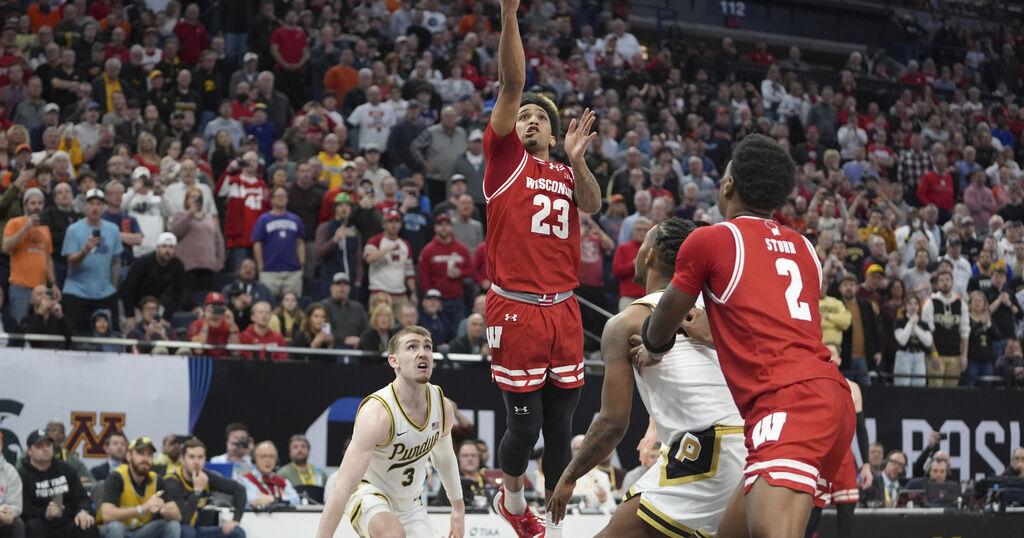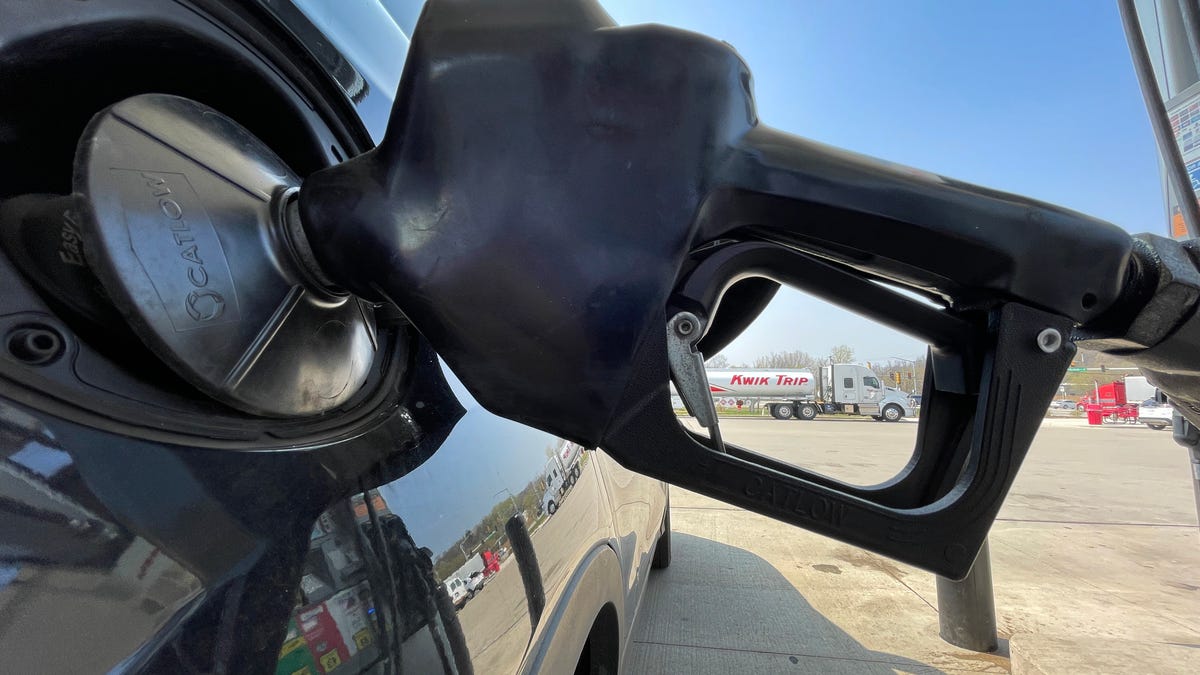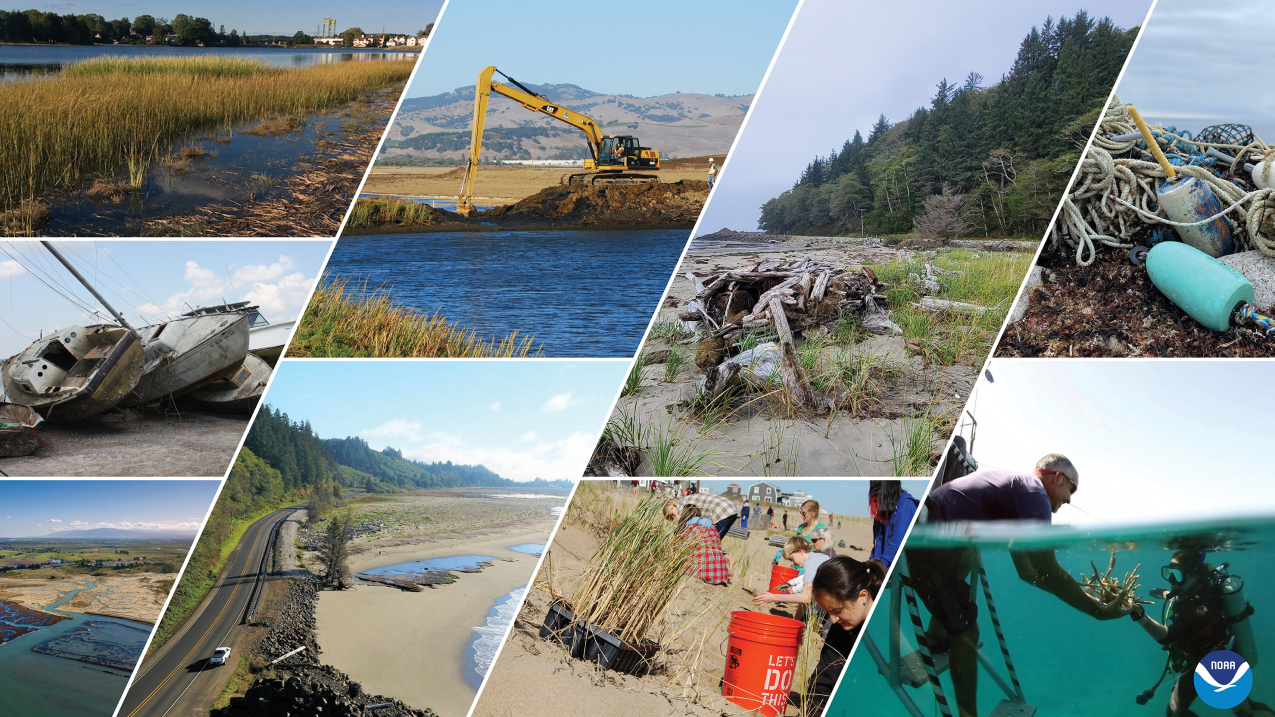MINNEAPOLIS â There are bad losses, but the one Sunday afternoon at the doesnât fit in that category for the University of Wisconsin menâs basketball team.
The Badgers won three games in four days at the Big Ten tournament. There were even plenty of encouraging signs in the lone defeat, a 93-87 setback against Illinois with the title on the line at the Target Center.
âWeâre leaving here today a much better team than when we came in on Wednesday,â Wisconsin coach Greg Gard said.
Wisconsin men’s basketball returns to NCAA Tournament after one-year absence
People are also reading…
Gard is right. Performances against Rutgers and Purdue during the final week of the regular season provided hints that the Badgers were trending back in the right direction following a horrific stretch in which they lost seven times in nine games.
These past four days confirmed that Wisconsin had indeed turned a corner just in time for the start of the NCAA Tournament.
The Badgers (22-13) earned a No. 5 seed in the South Region and will open against James Madison (31-3) at 8:40 p.m. Friday in Brooklyn, New York. Duke, which broke Wisconsinâs hearts in the 2015 NCAA final, could be waiting in the second round.
5 things to know about Wisconsin’s March Madness first-round opponent, James Madison
Hereâs my take on the draw for Gardâs team:
What I like
Wisconsin earning a No. 5 seed is fair.
Itâs hard to say if an overtime win over top-seeded Purdue caused the selection committee to move Wisconsin from the 6 line to the 5 line, but thatâs a fair assumption. Anything worse than a 6 would have been shocking, as would anything better than a 5.
Polzin: Upset of Purdue a microcosm of Wisconsin men’s basketball’s grit and belief
Wisconsin is the No. 19 overall seed. For as much as fans dwell on the Associated Press Top 25 rankings, what that means is the committee thought the Badgers have a top-20 resume.
And I agree with that assessment. Wisconsin played a tough schedule and had a respectable 14-13 record in Quad 1 and 2 games.
⢠A quick turnaround from an exhausting conference tournament run to a first-round NCAA Tournament game on Thursday would have been brutal. But the Badgers avoided that by being sent to Brooklyn.
Make no mistake, Wisconsin is banged up. The list of injured players starts with John Blackwell, Chucky Hepburn, Max Klesmit and Tyler Wahl. Thatâs four of the top six players in the Badgersâ rotation.
That extra day of rest is crucial.
âEverybody needs it,â Gard said. âWe just played four games in four days. Even I need it.â
⢠Thereâs also something to be said for having too much rest. While an extra day off is good for the Badgers, I think itâs important that theyâre riding a wave of momentum right now and probably want to get on the court as soon as possible.
James Madison won the Sun Belt Tournament on March 11, meaning the Dukes will have 11 days between games. That seems like a lot to me.
Polzin: Why Wisconsin’s Superman ‘with absolutely no ceiling’ is worth the stress he causes
âThese guys want to play,â Gard said. âThereâs nobody complaining about being banged up or anything. They were ready to go.â
⢠There are some big names in the South Region.
Duke and Kentucky are blue bloods. Houston, the No. 1 seed, has become a perennial contender under Kelvin Sampson.
Wahlâs eyes went right to Marquette at the bottom of Wisconsinâs portion of the bracket. A Badgers-Golden Eagles rematch in the Elite Eight would be fun even if that seems like a pipe dream right now.
Polzin: This ‘future leader’ of Wisconsin men’s basketball is already showing it
âYou donât know who youâre going to play,â Wahl said, âbut I think a really good team is going to come out of our side.â
What I donât like
I donât hate the Badgersâ first-round draw. But I donât love it, either.
It took CBS analyst Seth Davis about two seconds to pick James Madison over Wisconsin in a 12-5 upset. Iâm guessing that will be a popular opinion the next couple of days.
The Dukes are experienced and can put a lot of points on the board. Theyâre red-hot right now, too: James Madisonâs 13-game winning streak is the longest in the nation.
James Madison guard Noah Freidel (1) is pressured by Southern Mississippi guard Donovan Ivory (15) as he dribbles along the baseline during the second half of an NCAA college basketball game, Saturday, Jan. 6, 2024, in Hattiesburg, Miss. Southern Mississippi won 81-71. (AP Photo/Rogelio V. Solis)
Are the Dukes battle tested? Sort of. They opened the season with an overtime win at Michigan State, but Wisconsin won handily at the Breslin Center a month later.
James Madison only played a combined three games in Quad 1 and Quad 2. Twenty-two of its wins came in Quad 4 and another win â vs. Keystone College â doesnât even count in the NCAA Net Rankings.
Itâs a scary first-round opponent for the Badgers, but itâs not as bad as the one they drew as a No. 5 seed in 2019. Oregon was the No. 12 seed in that matchup and was coming off a run to the Pac-12 Tournament title.
⢠I donât have to tell you that Wisconsinâs defense has been awful at times this season.
Polzin: What I liked and didn’t like about Wisconsin’s Big Ten Tournament title loss to Illinois
It was again Sunday, when Illinois averaged 1.37 points per possession. That number after halftime was a whopping 1.58, with Terrence Shannon Jr. and Marcus Domask scoring at will against the Badgers.
Wisconsin has the offensive punch to make a run to the Final Four. But I donât trust its defense to get stops when needed.
This region includes two of the top 10 offenses in the nation â Kentucky is at No. 5 in adjusted offensive efficiency while Duke is at No. 7 â and James Madison averages 84.4 points per game.
The Badgers played well on defense against Maryland and Northwestern this week. They had good moments on that end of the court vs. Purdue, too, at least when they werenât getting called for fouls.
Junior’s decision-making critical in Wisconsin men’s basketball’s upset of Purdue
They still need to buckle down and stop opponents from getting such easy access to the rim. That could be the difference between Wisconsinâs season ending at the Barclays Center or continuing to Dallas next week.
My pick
The Badgers were upbeat following the loss to Illinois.
âI like where weâre sitting right now,â Klesmit said. âIâm proud of the all the dudes in here and how we responded when stuff kind of hit the fan earlier in February.â
The vibes with this team feel good right now. Hepburn had a great Big Ten Tournament, and AJ Storr and Steven Crowl were really good as well.
My bracket will include wins over James Madison and Duke before a loss to Houston in the Sweet 16.
Photos: Wisconsin men’s basketball plays Illinois in Big Ten Tournament title
Big 10 Championship Basketball

Illinois head coach Brad Underwood yells during the first half of an NCAA college basketball game against Wisconsin in the championship of the Big Ten Conference tournament, Sunday, March 17, 2024, in Minneapolis. (AP Photo/Abbie Parr)
Big 10 Championship Basketball

Wisconsin guard AJ Storr reacts after missing a shot during the first half of an NCAA college basketball game against Illinois in the championship of the Big Ten Conference tournament, Sunday, March 17, 2024, in Minneapolis. (AP Photo/Abbie Parr)
Big 10 Championship Basketball

Wisconsin guard AJ Storr (2) works toward the basket as Illinois guard Terrence Shannon Jr. (0) defends during the first half of an NCAA college basketball game in the championship of the Big Ten Conference tournament, Sunday, March 17, 2024, in Minneapolis. (AP Photo/Abbie Parr)
Big 10 Championship Basketball

Illinois guard Terrence Shannon Jr. (0) and head coach Brad Underwood talk during the first half of an NCAA college basketball game against Wisconsin in the championship of the Big Ten Conference tournament, Sunday, March 17, 2024, in Minneapolis. (AP Photo/Abbie Parr)
Big 10 Championship Basketball

Wisconsin guard AJ Storr (2) works toward the basket as Illinois guard Terrence Shannon, back, defends during the first half of an NCAA college basketball game in the championship of the Big Ten Conference tournament, Sunday, March 17, 2024, in Minneapolis. (AP Photo/Abbie Parr)
Big 10 Championship Basketball

Wisconsin forward Carter Gilmore shoots during the first half of an NCAA college basketball game against Illinois in the championship of the Big Ten Conference tournament, Sunday, March 17, 2024, in Minneapolis. (AP Photo/Abbie Parr)
Big 10 Championship Basketball

Illinois forward Quincy Guerrier (13) celebrates after making a 3-point shot during the first half of an NCAA college basketball game against Wisconsin in the championship of the Big Ten Conference tournament, Sunday, March 17, 2024, in Minneapolis. (AP Photo/Abbie Parr)
Big 10 Championship Basketball

Wisconsin guard AJ Storr (2) gestures after making a 3-point shot during the first half of an NCAA college basketball game against Illinois in the championship of the Big Ten Conference tournament, Sunday, March 17, 2024, in Minneapolis. (AP Photo/Abbie Parr)
Big 10 Championship Basketball

Wisconsin guard AJ Storr (2) gestures after making a 3-point shot during the first half of an NCAA college basketball game against Illinois in the championship of the Big Ten Conference tournament, Sunday, March 17, 2024, in Minneapolis. (AP Photo/Abbie Parr)
Big 10 Championship Basketball

Wisconsin guard John Blackwell reacts after missing a shot during the first half of an NCAA college basketball game against Illinois in the championship of the Big Ten Conference tournament, Sunday, March 17, 2024, in Minneapolis. (AP Photo/Abbie Parr)
Big 10 Championship Basketball

Illinois forwards Coleman Hawkins (33) and forward Quincy Guerrier (13) celebrate after the team’s win against Wisconsin in an NCAA college basketball game in the championship of the Big Ten Conference tournament, Sunday, March 17, 2024, in Minneapolis. (AP Photo/Abbie Parr)
Big 10 Championship Basketball

Illinois guard Terrence Shannon Jr. (0) gestures near Wisconsin guard Max Klesmit after making a 3-point basket during the second half of an NCAA college basketball game in the championship of the Big Ten Conference tournament, Sunday, March 17, 2024, in Minneapolis. (AP Photo/Abbie Parr)
Big 10 Championship Basketball

Illinois guard Terrence Shannon Jr. (0) celebrates toward forward Marcus Domask (3) as time expires in their victory over Wisconsin of an NCAA college basketball game in the championship of the Big Ten Conference tournament, Sunday, March 17, 2024, in Minneapolis. (AP Photo/Abbie Parr)
Big 10 Championship Basketball

Illinois players pose for a photo after their win over Wisconsin of an NCAA college basketball game in the championship of the Big Ten Conference tournament, Sunday, March 17, 2024, in Minneapolis. (AP Photo/Abbie Parr)
Big 10 Championship Basketball

Illinois players and coaches celebrate after their win over Wisconsin of an NCAA college basketball game in the championship of the Big Ten Conference tournament, Sunday, March 17, 2024, in Minneapolis. (AP Photo/Abbie Parr)
Big 10 Championship Basketball

Illinois guard Terrence Shannon Jr. (0) celebrates toward forward Marcus Domask (3) as time expires during the team’s win against Wisconsin in an NCAA college basketball game in the championship of the Big Ten Conference tournament, Sunday, March 17, 2024, in Minneapolis. (AP Photo/Abbie Parr)
Big 10 Championship Basketball

Wisconsin guard Max Klesmit (11) stands on the court as Illinois guard Terrence Shannon Jr. (0) gestures after making a 3-point shot during the second half of an NCAA college basketball game in the championship of the Big Ten Conference tournament, Sunday, March 17, 2024, in Minneapolis. (AP Photo/Abbie Parr)
Big 10 Championship Basketball

Illinois guard Terrence Shannon Jr. (0) shoots during the second half of an NCAA college basketball game against Wisconsin in the championship of the Big Ten Conference tournament, Sunday, March 17, 2024, in Minneapolis. (AP Photo/Abbie Parr)
Big 10 Championship Basketball

Illinois forward Ty Rodgers, left, and head coach Brad Underwood hug after the team’s win against Wisconsin after an NCAA college basketball game in the championship of the Big Ten Conference tournament, Sunday, March 17, 2024, in Minneapolis. (AP Photo/Abbie Parr)
Big 10 Championship Basketball

Wisconsin forward Tyler Wahl reacts after a foul called on Wisconsin during the second half of an NCAA college basketball game against Illinois in the championship of the Big Ten Conference tournament, Sunday, March 17, 2024, in Minneapolis. (AP Photo/Abbie Parr)
Big 10 Championship Basketball

Illinois forward Coleman Hawkins (33) dunks during the second half of an NCAA college basketball game against Wisconsin in the championship of the Big Ten Conference tournament, Sunday, March 17, 2024, in Minneapolis. (AP Photo/Abbie Parr)
Contact Jim Polzin at jpolzin@madison.com.
































